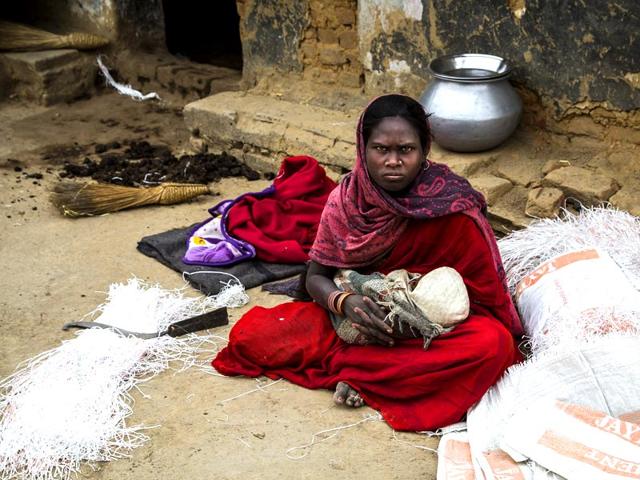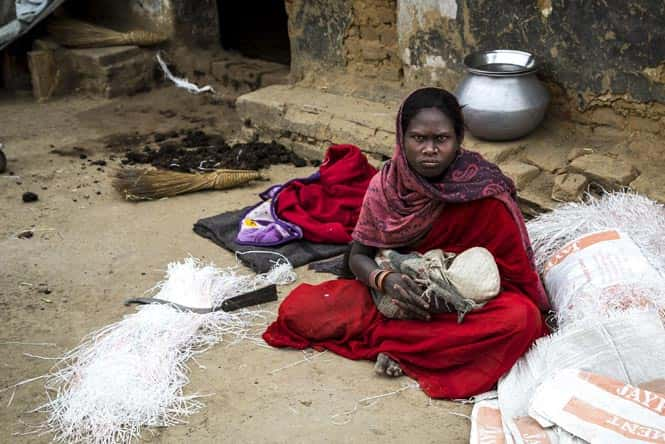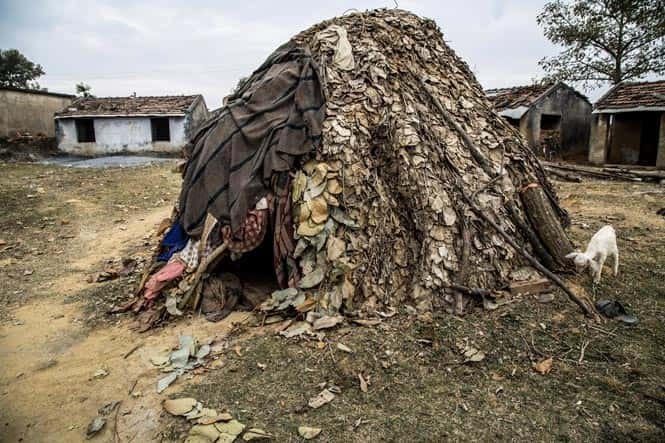Cut off from roots, Jharkhand's endangered tribes in battle for survival
The UNESCO has put Asur, Birhor and Korwa in its list of world’s endangered languages while Birhor has been tagged as 'critically endangered' with just 2,000 speakers left.
The reddish tinge of the soil is unmistakable. And the picture-postcard beauty of the countryside as the road meanders through dense forests in Jharkhand’s Pat region, which straddles Gumla and Latehar districts.
Dotted with deep ravines and hills rich in bauxite – which gives the colour to the soil – this region is also home to some of the most endangered tribes in the country: Birjias, Birhors, Korwa, Parhaiyas and Asurs. The area of their concentration is around 150 km from capital Ranchi and an hour-and-a-half’s drive from Bishunpur.


A Birhor woman with her child. (Abhishek Saha/HT Photo)
Along with a few other tribes like the Savar, Mal Paharia and Sauria Paharia – settled in other remote pockets across the state -- these eight form the particularly vulnerable tribal groups (PVTGs) of Jharkhand.
But after decades of half-hearted government intervention to rehabilitate the vulnerable tribes as settled communities, they have been reduced to just another poor section of society, lacking access to even the basic human needs like proper healthcare.
Their categorisation is based on their dwindling numbers, low literacy levels and the threat of extinction looming over their spoken languages. The PVTG category consists of 75 communities across the country.

A traditional Birhor hut made of leaves and branches. (Abhishek Saha/HT Photo)
These eight tribes were once nomadic forest-based hunting tribes but were later virtually forced by the government to settle down in remote pockets – arguably with neither the freedom of hunter-gatherers nor the skills of an industrial labour force.
29-year-old Vimal Asur, the first of his tribe to contest assembly elections in the state, explained the conundrum.
"With our land and forests snatched way, our traditional lifestyle is gone. On the other hand, we do not have the required skills and education to be a part of the modern industrial workforce. Thus, we are struck somewhere midway doing menial work or marginal farming and getting exploited," said Vimal, who was fielded by the Jharkhand Vikas Morcha (Prajatantrik). He, however, lost the polls.
The 2011 census threw up startling numbers of these tribes –a mere 6,000 of Birjias left in the state, the number of Savars stood at 9,000. The population of other tribes ranged from 10, 000 to 1.35 lakh.
The UNESCO has already put Asur, Birhor and Korwa in its list of world’s endangered languages while Birhor has been tagged as "critically endangered" with just 2,000 speakers left.
Experts said that forest regulations imposed during colonial times infringed upon the PVTG’s rights over forest products and eroded their societies.

Access to potable water is one of the biggest worries for the indigenous tribes of Jharkhand. They mostly depend on natural sources, like this stream in picture, for their drinking and washing needs. (Abhishek Saha/HT Photo)
Activists pointed out that non-implementation of the Forest Rights Act, 2006 has added to the age-old woes of the forest-based tribes.
"The issue of vulnerable tribes facing extinction can be addressed considerably with the implementation of Forest Rights Act because it basically returns to them the rights over forest products which they have lost over time. The Act can help develop a sustainable livelihood for them," said Birendra Kumar of the Naya Sawera Vikas Kendra, an organisation working for tribals in Jharkhand.
Vimal Soren, a social worker in Dumka district, said that on occasions Paharias have to carry their ill brethren on shoulders for over 50 km through hilly terrain for medical attention.
Salomi Horo, a government medical officer in Gumla district, said that infrastructural issues and lack of staff members at community health centres often come in the way of extending basic healthcare to these vulnerable tribes.
Ramesh Sharan, head of the department of economics in Ranchi University, felt that “whether the state should attempt at modernising the tribes is a different debate altogether, but once it has attempted at settling them, now providing basic rights like health and food are a must.”
Activists have questioned the very rationale behind forcing nomadic forest dwellers into settled communities and said the tribes should have the autonomy to decide how and where they want to live and what kind of a life they want to pursue.
“How can we pressurise communities into becoming like us leaving behind their traditional lifestyle? Who are we to say that? Who are we to decide?” asked Philip Kujur, a social worker based in Ranchi.
Get Current Updates on India News, Election 2024 along with Latest News and Top Headlines from India and around the world.




